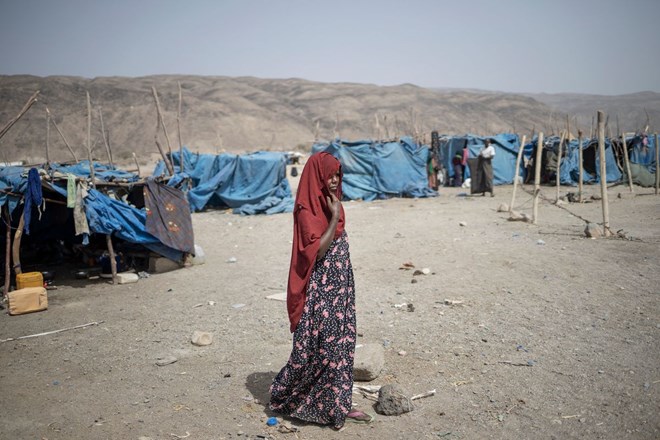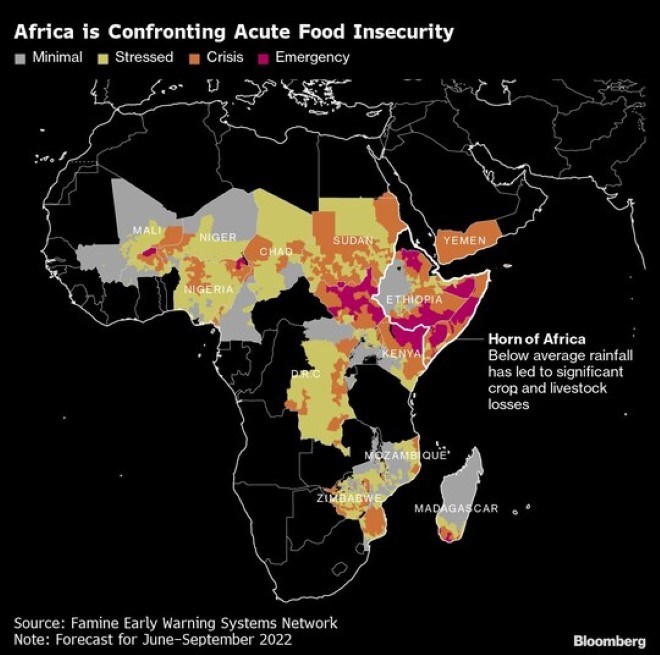
Wednesday August 17, 2022
Analysis by Mike Cohen

A humanitarian disaster is unfolding in East Africa, which is in the grip of its worst drought in at least four decades. More than 80 million people across Somalia, Ethiopia, Kenya, Sudan, South Sudan, Uganda and Djibouti are food insecure, and almost half of them are having to sell their possessions in order to eat, according to the World Health Organization. With forecasters seeing a high risk of rains failing for a fifth consecutive season and aid flows falling short of what’s needed, the region is at risk of a famine that’s on a par with -- or even worse than -- one that Ethiopia experienced in the 1980s and claimed an estimated 1 million lives.
1. How dire is the current situation?
Malnourishment is already widespread, especially among children, millions of whom need treatment. Millions of head of livestock have died, vast swathes of croplands have been decimated, and rural communities have been torn apart as families migrate in search of food and grazing. Many parents can’t afford to keep their children in school, drop-out rates have soared and there are reports of girls as young as nine being married off for dowry payments or to ease economic pressure on households. While Europe, parts of the US and other regions are also experiencing severe droughts, they are better equipped to deal with the fallout than cash-strapped African nations.
2. What’s the backdrop?
Climate change has resulted in extreme weather patterns, and nations across Africa have increasingly been contending with drought and flash floods. The coronavirus pandemic and Russia’s invasion of Ukraine have compounded the continent’s woes, making it more expensive and difficult to obtain supplies of food, fuel and fertilizer. Food prices have since eased, but relief has yet to filter through to most consumers. Hunger is especially pervasive in the Horn of Africa nations of Somalia, Ethiopia and Kenya, according to the Famine Early Warning Systems Network.
3. Are there other contributing factors?
An infestation of locusts, which thrive in hot and dry conditions, have wiped out crops across large parts of eastern Africa. Somalia and Ethiopia have also been contending with internal conflict that’s disrupted farming and made it dangerous to distribute aid. In Somalia, militant group al-Shabaab has been trying to topple the government since 2006 and impose its version of Islamic law. And in Ethiopia, the government and rebels from the northern Tigray region fought a civil war that dragged on for more than 16 months before a truce was agreed in March. Tensions are still high and relief agencies say getting access to conflict-hit areas remains challenging. Kenya held presidential elections on Aug. 9 that may have diverted some attention away from the drought.

4. Who has been trying to help?
The US says it gave more than $6.6 billion in humanitarian and food assistance to Africa in the first seven months of 2022, which would make it the single biggest donor. The European Union, Canada, Sweden, Germany and the UK were also leading contributors. Kenya’s government has introduced corn and fuel subsidies but says it can’t afford to maintain them indefinitely. While Somalia needs $1.5 billion to help 7 million needy people -- almost half the population -- only 79% had been pledged by early August, according to the UN Office for the Coordination of Humanitarian Affairs. The shortfall was even bigger for Ethiopia, with just a third of the $3.1 billion that’s required to help 20 million people committed.
5. What about West Africa?
The Sahel region is confronting a hunger crisis of its own, mainly due to ongoing conflict that’s decimated food production and exacerbated the impact of higher grain prices and the pandemic. More than 38 million people in the arid area on the southern fringe of the Sahara are food insecure, a 40% increase from a year ago, according to the Alliance for International Medical Action. Nigeria is contending with attacks by Islamic State and Boko Haram Islamist militants in the northeast of the country and a surge in banditry in the northwest, while insurgents have been wreaking havoc across Niger, Burkina Faso and Mali.